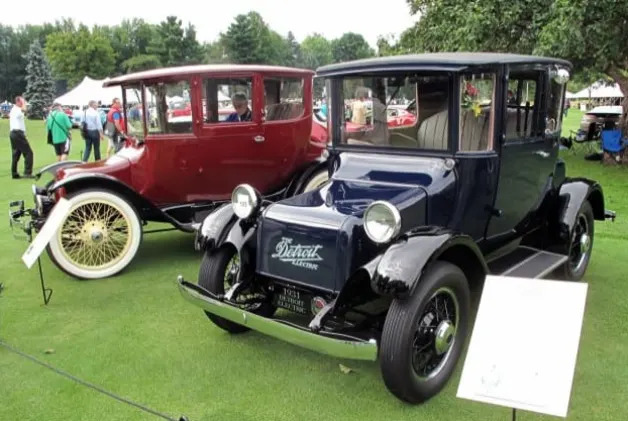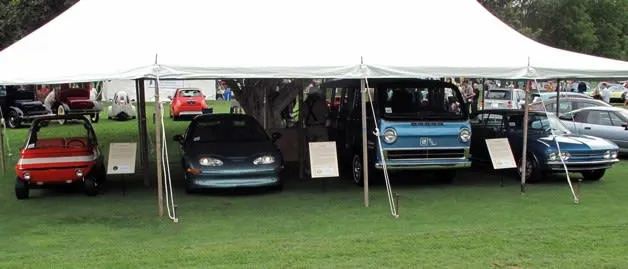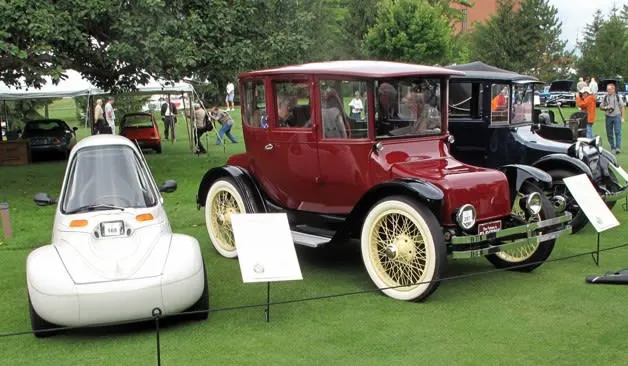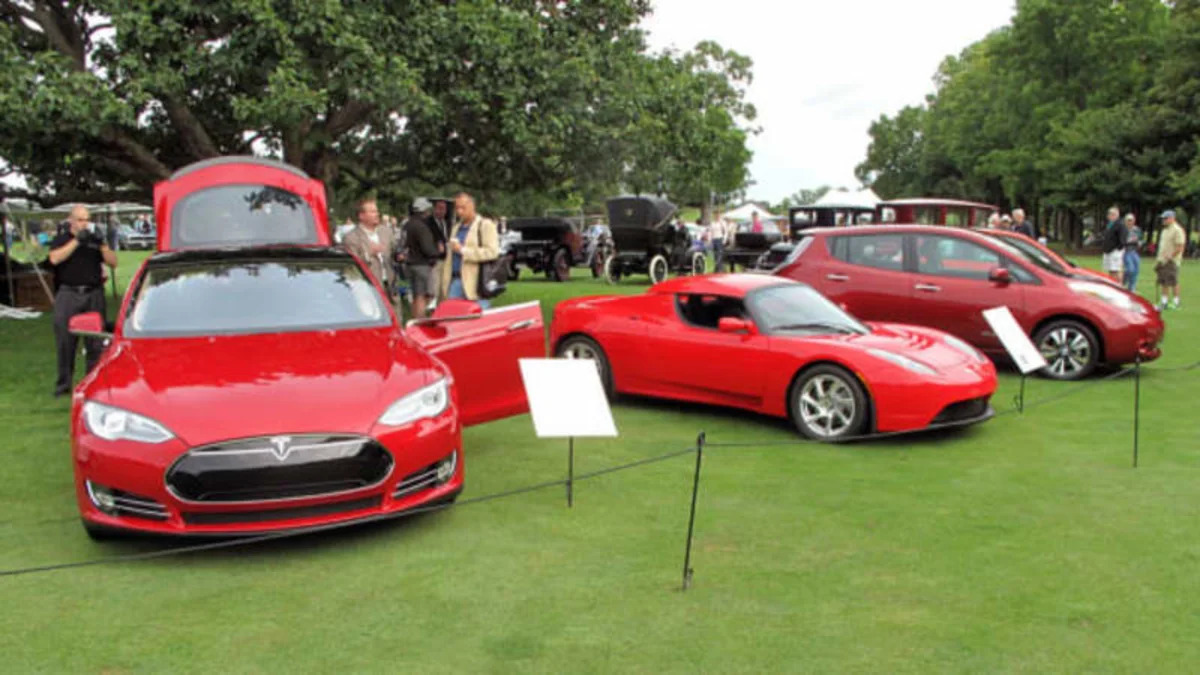A concours d'elegance (French for "parade of elegance") is a high-zoot, high-buck display of mostly pristine historic and collectible automobiles, most of them unaffordable to most of us. Probably the best known such events in the US are the nose-in-the-air Pebble Beach Concours in Monterey, CA, the younger, fresher Amelia Island Concours north of Jacksonville, FL and the Meadow Brook Concours in suburban Detroit.
But the 35-year-old celebration of rolling sculpture long known as Meadow Brook has changed names and locations. It's now at the bigger, better, easier-to-access Inn at St. Johns, a four-star hotel and golf course in Plymouth, west of Detroit. And, while it continues to offer row after row of Gaslight and Jazz Age entries, classic Cords, Duesenbergs, Auburns, Packards, Cadillacs and the like, its hard-working Selection Committee (on which I serve) does a great job each year of coming up with innovative cars and classes seldom seen elsewhere: 1893-1903 London to Brighton competitors; Racing Through the Ages; Vintage NASCAR; Jet-Age Convertibles and much more. For 2013, we picked a new theme: Electric Cars: Past, Present and Future.

The 20 cars in this terrific July 28 EV showcase ranged from an 1889 Edison Electric to a selection of 2014 EVs that included a Fiat 500e, a Chevrolet Spark EV, a Chevrolet Volt, a Nissan Leaf and a Cadillac ELR. Other notable entries: a 1907 Columbia Park Surrey, a 1911 Baker Electric, three Detroit Electrics and a 2010 Tesla Roadster. A great last-minute find was Jonathon Anderson's 2013 Tesla Model S which, we found just a week before the show after Tesla (in typical form) declined at the last minute to send one. Other interesting entries:
1921 Milburn Electric Model 27L - The Toledo, Ohio-based Milburn Wagon Company was building bodies for the Ohio Electric Car Company, among others, before beginning to build its own electric cars in September, 1914. The Milburn plant, along with 30 completed vehicles and a number of bodies, was destroyed by fire In 1919, but production resumed the following year in a building on the grounds of Toledo University. After General Motors purchased the plant in February 1923, Milburn's remaining operations moved to a smaller location and continued producing electric trucks and some cars through that year for a total of more than 4,000.

1966 GM Electrovair II prototype - Back in the mid 1960s, GM was exploring futuristic vehicles with alternative power sources, including electricity, and this 1966 Electrovair II concept was a test bed for electric motor and control development. Its 532-volt silver-zinc battery pack used up its front trunk and what had been its rear engine compartment. Strictly an engineering exercise, it was never intended for production. Given cheap and stable gasoline prices at the time, the American public showed little interest in electric cars.
1969 GM 512 Electric Experimental - Because lead-acid (PbA) batteries are big, heavy and don't hold much energy, and because PbA was the only practical, affordable choice at the time, many experimental electrics of the 1960s and 1970s were tiny two-seat "urban" vehicles not much more useful than golf carts. The idea was to minimize the vehicle's weight to compensate for its porky battery weight and squeeze as much driving range as possible out of a modest-size battery pack. The 512 was GM's 1969 take on that theme. Its pod-like fiberglass body – just 86 inches long and 56 inches wide – sits on a midget 52-inch-wheelbase steel chassis/floorpan with an integral roll bar. Its curb weight is just 1,250 pounds.
1997 GM EV1 - GM was in dire financial straits when work on this production electric car began, and the program was put on hold by then-new CEO Jack Smith just 16 months later. A core team of about 100 engineers continued development, and 50 prototypes were hand-built for a 1994 "PrEView Drive" program that loaned them to regular folks for three months in a dozen US cities. GM's Board of Directors revived the program in March, 1994, and the team became GM's Advanced Technology Vehicles (ATV) Division with a mission to lead the industry in EV technology and sell it to other automakers that chose not to invest billions of dollars to develop their own. The 1997 EV1 was available for lease (only) to residents of Los Angeles, CA and Phoenix and Tucson, AZ through designated Saturn dealerships. The upgraded '99 Gen II model offered optional Nickel-Metal Hydride (NiMH) batteries that doubled its range (at much higher cost), and availability expanded to San Francisco and Sacramento, CA. But far too few were leased to sustain the program, so it was canceled the following year.

2000 Corbin Sparrow - The tiny, three-wheeled Corbin Sparrow electric car was built by Corbin Motors in Hollister, California from 1999-2002. They came in two different bodystyles, "jellybean" and "pizzabutt," the latter because Domino's Pizza ordered several to use as delivery vehicles. Painted in bright yellow, silver, coral, aqua, lilac, teal, green, blue, magenta, white, orange, lime green or two-tone with polka dots, just 285 were built (100 jellybeans, 185 pizzabutts) and very few remain on the road today.
Many thanks to the General Motors Heritage Center for sending over the Electrovair and Electrovan, the 512 city car and the first 1992 "Impact" pre-production EV1 prototype, but the latter was a disappointing last-minute substitute for the original Impact concept car that wowed the 1990 Los Angeles Auto Show and led to the EV1 production program. Other notable (invited and entered) no-shows were the sole surviving Oldsmobile electric prototype from 1899, a 2012 Fisker Karma and a (Lotus-based) 2014 Detroit Electric Roadster, a revival of sorts of the old brand. Still, it was a great display of electric cars from the distant past through the near future, and a Concours first.
But the 35-year-old celebration of rolling sculpture long known as Meadow Brook has changed names and locations. It's now at the bigger, better, easier-to-access Inn at St. Johns, a four-star hotel and golf course in Plymouth, west of Detroit. And, while it continues to offer row after row of Gaslight and Jazz Age entries, classic Cords, Duesenbergs, Auburns, Packards, Cadillacs and the like, its hard-working Selection Committee (on which I serve) does a great job each year of coming up with innovative cars and classes seldom seen elsewhere: 1893-1903 London to Brighton competitors; Racing Through the Ages; Vintage NASCAR; Jet-Age Convertibles and much more. For 2013, we picked a new theme: Electric Cars: Past, Present and Future.

The 20 cars in this terrific July 28 EV showcase ranged from an 1889 Edison Electric to a selection of 2014 EVs that included a Fiat 500e, a Chevrolet Spark EV, a Chevrolet Volt, a Nissan Leaf and a Cadillac ELR. Other notable entries: a 1907 Columbia Park Surrey, a 1911 Baker Electric, three Detroit Electrics and a 2010 Tesla Roadster. A great last-minute find was Jonathon Anderson's 2013 Tesla Model S which, we found just a week before the show after Tesla (in typical form) declined at the last minute to send one. Other interesting entries:
1914, 1916 and 1931 Detroit Electrics - The Anderson Electric Car Company of Detroit built nearly 13,000 Detroit Electric EVs between 1907 and 1939. Production peaked at 1,000-2,000 a year in the 1910s before a name change to "The Detroit Electric Car Company" in 1920 to separate it from Anderson's body and motor/controller businesses. EV sales withered in the 1920s, but the company continued building them until the 1929 stock market crash, then filed for bankruptcy, was acquired and filled special orders until the last one was shipped on February 23, 1939.Detroit Electric EV production peaked at 1,000-2,000 a year in the 1910s.
1921 Milburn Electric Model 27L - The Toledo, Ohio-based Milburn Wagon Company was building bodies for the Ohio Electric Car Company, among others, before beginning to build its own electric cars in September, 1914. The Milburn plant, along with 30 completed vehicles and a number of bodies, was destroyed by fire In 1919, but production resumed the following year in a building on the grounds of Toledo University. After General Motors purchased the plant in February 1923, Milburn's remaining operations moved to a smaller location and continued producing electric trucks and some cars through that year for a total of more than 4,000.

1966 GM Electrovair II prototype - Back in the mid 1960s, GM was exploring futuristic vehicles with alternative power sources, including electricity, and this 1966 Electrovair II concept was a test bed for electric motor and control development. Its 532-volt silver-zinc battery pack used up its front trunk and what had been its rear engine compartment. Strictly an engineering exercise, it was never intended for production. Given cheap and stable gasoline prices at the time, the American public showed little interest in electric cars.
1966 GM Electrovan prototype - This is reportedly the first fuel-cell-powered vehicle ever built. Looking more like an old whisky still than an exhaust-free vehicle propulsion system, its interior contains one large tank for the hydrogen, another for the oxygen, and 550 feet of piping that barely leaves room for a driver and one passenger. Following a demonstration for journalists in 1966, the project was scrapped because it was cost-prohibitive and there was no hydrogen infrastructure in place.Following a demonstration in 1966, the GM Electrovan project was scrapped because it was cost-prohibitive and there was no hydrogen infrastructure in place.
1969 GM 512 Electric Experimental - Because lead-acid (PbA) batteries are big, heavy and don't hold much energy, and because PbA was the only practical, affordable choice at the time, many experimental electrics of the 1960s and 1970s were tiny two-seat "urban" vehicles not much more useful than golf carts. The idea was to minimize the vehicle's weight to compensate for its porky battery weight and squeeze as much driving range as possible out of a modest-size battery pack. The 512 was GM's 1969 take on that theme. Its pod-like fiberglass body – just 86 inches long and 56 inches wide – sits on a midget 52-inch-wheelbase steel chassis/floorpan with an integral roll bar. Its curb weight is just 1,250 pounds.
1997 GM EV1 - GM was in dire financial straits when work on this production electric car began, and the program was put on hold by then-new CEO Jack Smith just 16 months later. A core team of about 100 engineers continued development, and 50 prototypes were hand-built for a 1994 "PrEView Drive" program that loaned them to regular folks for three months in a dozen US cities. GM's Board of Directors revived the program in March, 1994, and the team became GM's Advanced Technology Vehicles (ATV) Division with a mission to lead the industry in EV technology and sell it to other automakers that chose not to invest billions of dollars to develop their own. The 1997 EV1 was available for lease (only) to residents of Los Angeles, CA and Phoenix and Tucson, AZ through designated Saturn dealerships. The upgraded '99 Gen II model offered optional Nickel-Metal Hydride (NiMH) batteries that doubled its range (at much higher cost), and availability expanded to San Francisco and Sacramento, CA. But far too few were leased to sustain the program, so it was canceled the following year.

2000 Corbin Sparrow - The tiny, three-wheeled Corbin Sparrow electric car was built by Corbin Motors in Hollister, California from 1999-2002. They came in two different bodystyles, "jellybean" and "pizzabutt," the latter because Domino's Pizza ordered several to use as delivery vehicles. Painted in bright yellow, silver, coral, aqua, lilac, teal, green, blue, magenta, white, orange, lime green or two-tone with polka dots, just 285 were built (100 jellybeans, 185 pizzabutts) and very few remain on the road today.
Many thanks to the General Motors Heritage Center for sending over the Electrovair and Electrovan, the 512 city car and the first 1992 "Impact" pre-production EV1 prototype, but the latter was a disappointing last-minute substitute for the original Impact concept car that wowed the 1990 Los Angeles Auto Show and led to the EV1 production program. Other notable (invited and entered) no-shows were the sole surviving Oldsmobile electric prototype from 1899, a 2012 Fisker Karma and a (Lotus-based) 2014 Detroit Electric Roadster, a revival of sorts of the old brand. Still, it was a great display of electric cars from the distant past through the near future, and a Concours first.


Sign in to post
Please sign in to leave a comment.
Continue